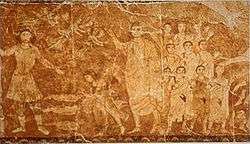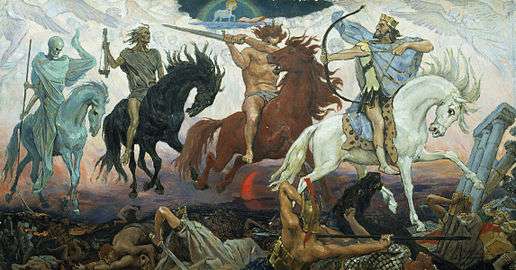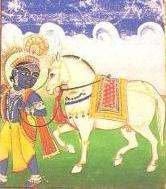World to come
The world to come, age to come, and heaven on Earth are eschatological phrases reflecting the belief that the current world or current age is flawed or cursed and will be replaced in the future by a better world, age, or paradise. The concept is related to but differs from the concepts of heaven, the afterlife, and the Kingdom of God in that heaven is another place or state generally seen as above the world, the afterlife is generally an individual's life after death, and the Kingdom of God could be in the present (such as realized eschatology) or the future.
The following section reviews religions chronologically by date of the composition of various religious texts, from oldest to most recent, although the chronology of ancient religions is not known with certainty. Later dates are more certain than earlier dates.
Zoroastrian eschatology
In Zoroastrian eschatology, the world to come is the frashokereti, where the saoshyant will bring about a resurrection of the dead in the bodies they had before they died. This is followed by a last judgment. The yazatas Airyaman and Atar will melt the metal in the hills and mountains, and the molten metal will then flow across the earth like a river. All humankind—both the living and the resurrected dead—will be required to wade through that river, but for the righteous (ashavan) it will seem to be a river of warm milk, while the wicked will be burned. The river will then flow down to hell, where it will annihilate Angra Mainyu and the last vestiges of wickedness in the universe. The saoshyant is first mentioned as a savior in the Yashts written around 625 and 225 BCE [1]
Jewish eschatology

HaOlam HaBa, or "the world to come", is an important part of Jewish eschatology, although Judaism concentrates on the importance of HaOlam HaZeh ("this world"). The afterlife is known as Olam haBa, Gan Eden (the Heavenly Garden of Eden) and Gehinom.[2][3][4] According to the Talmud, any non-Jew who lives according to the Seven Laws of Noah is regarded as a Ger toshav (righteous gentile), and is assured of a place in the world to come, the final reward of the righteous.[5][6]
Legends
In the 19th century book Legends of the Jews, Louis Ginzberg compiled Jewish legends found in rabbinic literature. Among the legends are ones about the world to come and the two Gardens of Eden. The world to come is called Paradise, and it is said to have a double gate made of carbuncle that is guarded by 600,000 shining angels.[7] Seven clouds of glory overshadow Paradise, and under them, in the center of Paradise, stands the tree of life. [8] The tree of life overshadows Paradise too, and it has fifteen thousand different tastes and aromas that winds blow all across Paradise.[9] Under the tree of life are many pairs of canopies, one of stars and the other of sun and moon, while a cloud of glory separates the two. In each pair of canopies sits a rabbinic scholar who explains the Torah to one.[10] When one enters Paradise one is proffered by Michael (archangel) to God on the altar of the temple of the heavenly Jerusalem,[11] whereupon one is transfigured into an angel (the ugliest person becomes as beautiful and shining as "the grains of a silver pomegranate upon which fall the rays of the sun").[12] The angels that guard Paradise's gate adorn one in seven clouds of glory, crown one with gems and pearls and gold, place eight myrtles in one's hand, and praise one for being righteous while leading one to a garden of eight hundred roses and myrtles that is watered by many rivers.[13] In the garden is one's canopy, its beauty according to one's merit, but each canopy has four rivers - milk, honey, wine, and balsam[14] - flowing out from it, and has a golden vine and thirty shining pearls hanging from it.[15] Under each canopy is a table of gems and pearls attended to by sixty angels.[16] The light of Paradise is the light of the righteous people therein.[17] Each day in Paradise one wakes up a child and goes to bed an elder to enjoy the pleasures of childhood, youth, adulthood, and old age.[18] In each corner of Paradise is a forest of 800,000 trees, the least among the trees greater than the best herbs and spices,[19] attended to by 800,000 sweetly singing angels.[20] Paradise is divided into seven paradises, each one 120,000 miles long and wide.[21] Depending on one's merit, one joins one of the paradises: the first is made of glass and cedar and is for converts to Judaism; the second is of silver and cedar and is for penitents; the third is of silver and gold, gems and pearls, and is for the patriarchs, Moses and Aaron, the Israelites that left Egypt and lived in the wilderness, and the kings of Israel; the fourth is of rubies and olive wood and is for the holy and steadfast in faith; the fifth is like the third, except a river flows through it and its bed was woven by Eve and angels, and it is for the Messiah and Elijah; and the sixth and seventh divisions are not described, except that they are respectively for those who died doing a pious act and for those who died from an illness in expiation for Israel's sins.[22]
Beyond Paradise, according to Legends of the Jews, is the higher Gan Eden, where God is enthroned and explains the Torah to its inhabitants.[23] The higher Gan Eden contains three hundred ten worlds and is divided into seven compartments.[24] The compartments are not described, though it is implied that each compartment is greater than the previous one and is joined based on one's merit.[25] The first compartment is for Jewish martyrs, the second for those who drowned, the third for "Rabbi Johanan ben Zakkai and his disciples," the fourth for those whom the cloud of glory carried off, the fifth for penitents, the sixth for youths who have never sinned; and the seventh for the poor who lived decently and studied the Torah.[26]
Christian eschatology

In Christianity, the phrase is found in the Nicene Creed (current Ecumenical version): "We look for the resurrection of the dead, and the life of the world to come."[27] It is also found in the King James Version of the New Testament at Matthew 12:32, Mark 10:30, Luke 18:30, Hebrews 2:5, Hebrews 6:5. Other related expressions are "age to come" which is typically found in more recent translations, Kingdom of God, Messianic Age, Millennial Age, The New Earth and New Jerusalem, and dispensation of the fulness of times and possibly also eternal life.
Hindu eschatology

In Hindu eschatology the current age is the Kali Yuga, a period of decline. Kalki will appear to purge all evil, beginning a golden age of Satya Yuga.
There have been a range of dates predicted, purportedly from different methods of calculation.[28] Pothuluru Veerabrahmendra, for example, wrote 400 years ago in his Divya Maha Kala Gnana, or 'Divine Knowledge of the Time,' that Kalki would arrive when the moon, sun, Venus and Jupiter entered the same sign. This is not a rare occurrence and last happened in early 2012, passing without event.[29] The time of arrival of Kalki has not been consistently asserted by astrologers.[28]
The earliest copies of the Mahabharata that exist dates from 200 CE and is the first text to mention Kalki but was likely written in its final form around 400 CE. Kalki is also mentioned in the Vishnu Purana which has a contested date of composition ranging from 400 BCE to 1000 CE.
References
- Livius
- Jews are told to live their lives on earth to the full, as their bodies will stay there but their souls live on. Jewish Afterlife Beliefs at SimpleToRemember.com
- Afterlife at JewishVirtualLibrary.org
- Olam Ha-Ba: The Afterlife at JewFAQ.org
- Mishneh Torah, Hilkhot M'lakhim 8:11
- Encyclopedia Talmudit (Hebrew edition, Israel, 5741/1981, entry Ben Noah, end of article); note the variant reading of Maimonides and the references in the footnote
- The Sacred Texts: Legends of the Jews, Chapter 1
- The Sacred Texts: Legends of the Jews, Chapter 1
- The Sacred Texts: Legends of the Jews, Chapter 1
- The Sacred Texts: Legends of the Jews, Chapter 1
- The Sacred Page: Legends of the Jews, Chapter 1
- The Sacred Texts: Legends of the Jews, Chapter 1
- The Sacred Texts: Legends of the Jews, Chapter 1
- The Sacred Texts: Legends of the Jews, Chapter 1
- The Sacred Texts: Legends of the Jews, Chapter 1
- The Sacred Texts: Legends of the Jews, Chapter 1
- The Sacred Texts: Legends of the Jews, Chapter 1
- The Sacred Texts: Legends of the Jews, Chapter 1
- The Sacred Texts: Legends of the Jews, Chapter 1
- The Sacred Texts: Legends of the Jews, Chapter 1
- The Sacred Texts: Legends of the Jews, Chapter 1
- The Sacred Texts: Legends of the Jews, Chapter 1
- The Sacred Texts: Legends of the Jews, Chapter 1
- The Sacred Texts: Legends of the Jews, Chapter 1
- The Sacred Texts: Legends of the Jews, Chapter 1
- The Sacred Texts: Legends of the Jews, Chapter 1
- "The Nicene Creed". Christian-bible.com. Retrieved 2012-01-08.
- Chandra, Suresh (Aug 15, 2012). Encyclopaedia of Hindu Gods and Goddesses. Kindle Edition.
- Santanu Acharya. "Hindu Prophecies: Translations from the Kalki Purana". Ww-iii.tripod.com. Retrieved 2013-01-20.